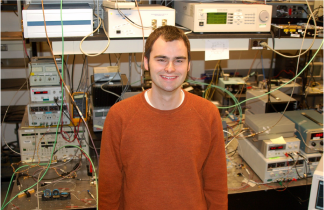
Above: reproduced from Ref. 1. Magnetomotion OCT (MM-OCT) of chicken breast tissue.
CLEO conference organizers recently posted the categories for the Special Symposia which are to include five areas: 1) Nano-bio-photonics, 2) Broadband Spectroscopy: New Techniques and Sources, 3) Quantum Communications, 4) Fiber Parametric Devices and Applications, and 5) Light-emitting Nano-plasmonic Devices.
Among other invited speakers in the Nano-bio-photonics Symposium, Stephen Boppart from University of Illinois, Urbana-Champaign, will be discussing "Endogenous Molecules or Exogenous Molecularly Targeted Contrast Agents for OCT." OCT, or Optical Coherence Tomography, was pioneered in the early 1990's by James Fujimoto of MIT, who will also be giving an invited talk in this Symposium. OCT uses the cleverness of interfering low-coherence light to scan through tissue to depths up to a few millimeters and with an axial resolution equivalent to the coherence length of the source, typically less than 10 microns. Complete OCT setups can be purchased commercially, like Thorlab's OCS1300SS. In fact, during my last eye-checkup I asked my optometrist if she had heard of OCT since they are becoming more widely used by opthamologists to probe retinal health and conditions. She did. In fact she had participated in a clinic to understand how to use OCT and read images.Though roubst, OCT has been limited to a small number of medical applications because it is insensitive to standard molecular probes used by biomedical researchers such as fluorophores or bioluminescent markers. This is because fluorescence and bioluminescence arise from inelastically scattered light, and OCT is sensitive only to elastically scattered light (light coherent with the source). Therefore, in order to use molecular probes with OCT to diagnose a wider variety of diseases or to answer fundamental questions of cellular function, one must use a different set of probes that are sensitive to elastic scattering properties of light like changes in scattering itself, absorption, polarization, phase, or frequency.1
From the title of the talk, I imagine that Professor Boppart will be discussing some of the exogenous probes (probes introduced into the tissue) he and his group have created and used for OCT like metallic nanoshells and microspheres engineered from a variety of materials to enhance scattering.1 My favorite of the ingenuous probes are particles with high magnetic susceptibilities such that when modulated with a magnetic field, their subsequent motion changes the local scattering properties of the tissue, see the figure above.1 I also suspect he will be talking about endogenous probes (where the tissue of interest naturally contains helpful probes) like collagen that can be stimulated by a coherent process like second harmonic generation, or Hb/HbO2 whose scattering and absorbing properties are frequency-dependent.1 I'm excited to hear advances in this work as well as attend the other symposia.The latter four symposia are open for submission of contributed papers and you can find the CLEO or QELS subcategory to which to submit beneath the particular symposium description. I'm particularly interested in the Broadband Spectroscopy Symposium since one of the emphases is Mid IR sources, a new interest of mine. I also am excited that the Quantum Communication Symposium, which like the Nano-bio-photonic Symposium, has been placed under the designations of QELS: Fundamental Science, and CLEO: Science and Innovation, and CLEO: Applications and Technology. These symposia will attempt to show their fields from the idea-stage all the way to commercialization.
So if you think you're special (which if you're planning on submitting work to CLEO you most certainly are), take a moment to see if your work falls into the Special Symposia categories.References
1. S. A. Boppart et al., "Optical probes and techniques for molecular contrast enhancement in coherence imaging ," Journal of Biomedical Optics, 10, 041208, (2005).